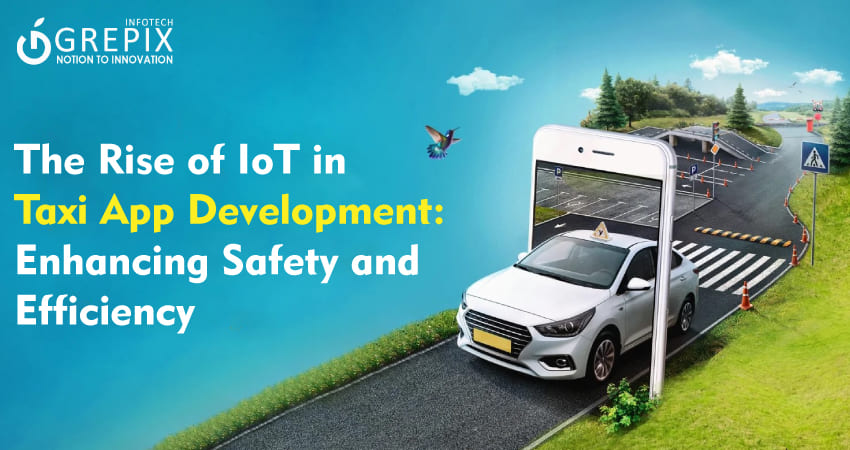The Rise of IoT in Taxi App Development: Enhancing Safety and Efficiency
In today's fast-paced world, technology has become an integral part of our daily lives, revolutionizing various industries and sectors. One such sector that has witnessed a significant transformation is transportation, especially with the advent of taxi app development. These apps have not only simplified the way we commute but have also enhanced safety and efficiency, thanks to the integration of Internet of Things (IoT) technology.
As a leading taxi app development company, we have observed firsthand the evolution of IoT and its impact on the transportation industry. In this blog, we delve into the rise of IoT in taxi app development and how it is revolutionizing the way people travel while ensuring safety and efficiency.
The blog discusses how IoT integration in taxi app development revolutionizes transportation. It highlights real-time fleet management, enhanced safety measures like cameras and panic buttons, and predictive maintenance. Personalized passenger experiences and data-driven insights further improve efficiency and customer satisfaction. IoT ensures precise tracking, deterring incidents and aiding in swift responses. Route optimization reduces travel time and emissions, while streamlined payment systems enhance convenience. The future promises even more advancements, including AI integration and synergy with emerging tech like blockchain and augmented reality, ultimately shaping smarter and sustainable urban mobility.
Impact of IoT on Taxi App Development
In the rapidly evolving landscape of transportation, the integration of Internet of Things (IoT) technology has brought about a revolutionary change in taxi and dispatch systems. Gone are the days of traditional dispatch methods; today, IoT is reshaping the way taxi companies operate, offering unprecedented levels of efficiency, safety, and convenience. In this blog, we explore the profound impact of IoT on taxi and dispatch systems, and how it is redefining the future of urban mobility.
Real-Time Fleet Management
One of the most significant advantages of IoT in taxi and dispatch systems is real-time fleet management. With the help of GPS-enabled devices and sensors installed in vehicles, taxi companies can monitor the location, speed, and status of each vehicle in their fleet in real-time. This level of visibility allows for better coordination and optimization of resources, leading to improved efficiency and reduced wait times for passengers.
Also Read: "Why inDriver Clone App Is the Best Choice for Budget-Friendly Rideshare"
Enhanced Safety Measures
Safety is paramount in the transportation industry, and IoT plays a crucial role in enhancing safety measures for both passengers and drivers. Through the integration of IoT devices such as cameras, panic buttons, and sensors, taxi companies can ensure a safer and more secure ride experience. Cameras installed inside vehicles act as a deterrent to misconduct and provide valuable evidence in case of incidents. Panic buttons enable passengers to alert authorities in emergency situations, while sensors can detect sudden movements or collisions, triggering immediate response actions.
Predictive Maintenance
IoT-enabled sensors installed in vehicles can monitor various parameters such as engine health, fuel levels, and tire pressure in real-time. By analyzing this data, taxi companies can implement predictive maintenance strategies, proactively identifying and addressing potential issues before they escalate into costly breakdowns or accidents. This not only reduces maintenance costs but also minimizes downtime, ensuring that vehicles remain in optimal condition and ready for service at all times.
Personalized Passenger Experience
IoT technology allows taxi companies to offer a more personalized and seamless experience to passengers. Through mobile apps integrated with IoT devices, passengers can track the arrival time of their ride in real-time, receive notifications and updates, and even customize their ride preferences. For example, passengers can specify their preferred temperature, music, or route preferences, creating a more comfortable and enjoyable ride experience.
Data-Driven Insights
One of the most valuable aspects of IoT in taxi dispatch systems is the wealth of data generated by connected devices. By analyzing this data, taxi companies can gain valuable insights into passenger behavior, traffic patterns, demand trends, and operational efficiency. This data-driven approach enables informed decision-making, allowing taxi companies to optimize routes, pricing strategies, and resource allocation for maximum profitability and customer satisfaction.
Enhancing Safety with IoT
Safety is paramount when it comes to transportation, and IoT plays a crucial role in enhancing safety measures in taxi app development. With the integration of IoT devices such as GPS trackers, cameras, and sensors, taxi companies can monitor their fleet in real-time, ensuring the safety of both passengers and drivers.
GPS trackers enable precise tracking of the vehicle's location, allowing taxi companies to keep track of their fleet's movements. In case of any emergencies or safety concerns, such as accidents or unauthorized stops, real-time alerts can be sent to the central monitoring system, enabling swift action to be taken.
Furthermore, the deployment of cameras inside taxis provides an added layer of security, deterring potential criminals and ensuring accountability among drivers. In the event of any untoward incidents, footage from these cameras can serve as valuable evidence for investigations and legal proceedings.
Additionally, IoT sensors can monitor various vehicle metrics such as speed, acceleration, and fuel consumption, helping taxi companies identify any anomalies or potential issues with the vehicles. This proactive approach to maintenance not only enhances safety but also reduces the risk of breakdowns and accidents.
Improving Efficiency with IoT
In addition to safety, IoT technology also enhances the efficiency of taxi app development, benefiting both passengers and service providers alike. One of the key ways IoT improves efficiency is through route optimization. By analyzing real-time traffic data and passenger demand patterns, taxi apps can suggest the most efficient routes to drivers, minimizing travel time and fuel consumption. This not only improves the overall efficiency of the transportation system but also reduces carbon emissions, contributing to a more sustainable environment.
Moreover, IoT-enabled payment systems streamline the payment process, allowing passengers to pay seamlessly through the app without the need for cash or cards. This not only enhances the convenience for passengers but also reduces transaction times, enabling drivers to serve more customers in less time.
The Future of IoT in Taxi App Development
As technology continues to advance, the future of IoT in taxi app development looks promising. With advancements in artificial intelligence and machine learning, taxi apps can become even more intuitive and predictive, offering personalized recommendations and optimizing the entire transportation experience.
Furthermore, the integration of IoT with other emerging technologies such as blockchain and augmented reality holds immense potential for transforming the transportation landscape further. From enhancing security and transparency to enabling immersive passenger experiences, the possibilities are endless.In conclusion, the rise of IoT in taxi app development has ushered in a new era of safety and efficiency in transportation. By leveraging IoT technology, taxi companies can not only improve the overall passenger experience but also contribute to building smarter and more sustainable cities for the future. As a leading taxi app development company, we are committed to harnessing the power of IoT to drive innovation and shape the future of transportation.
Conclusion
In conclusion, the integration of IoT technology into taxi app development marks a significant advancement in the transportation industry, revolutionizing the way people move from one place to another. By leveraging IoT devices and sensors, taxi app companies can enhance both the safety and efficiency of their services.
Through real-time monitoring of vehicles, drivers, and passengers, IoT-enabled taxi apps ensure a safer travel experience for everyone involved. From tracking driver behavior to detecting potential hazards on the road, these technologies provide valuable insights that enable swift responses to emergencies, ultimately reducing the risk of accidents and improving overall safety standards.
Moreover, IoT integration optimizes the efficiency of taxi services by streamlining operations and minimizing downtime. With features such as predictive maintenance, route optimization, and demand forecasting, taxi companies can maximize the utilization of their fleet, reduce fuel consumption, and minimize wait times for passengers. This not only benefits the service providers but also enhances the overall experience for passengers, making their journeys more convenient and reliable.
As the IoT continues to evolve and innovate, we can expect further enhancements in taxi app development, leading to even greater levels of safety, efficiency, and customer satisfaction. By embracing these technologies, taxi companies can stay ahead of the curve and deliver exceptional service in an increasingly connected world.
Looking out to start your own venture like Uber? Try out our HireMe Taxi Uber Clone, the easiest way to kick-start your taxi business.







